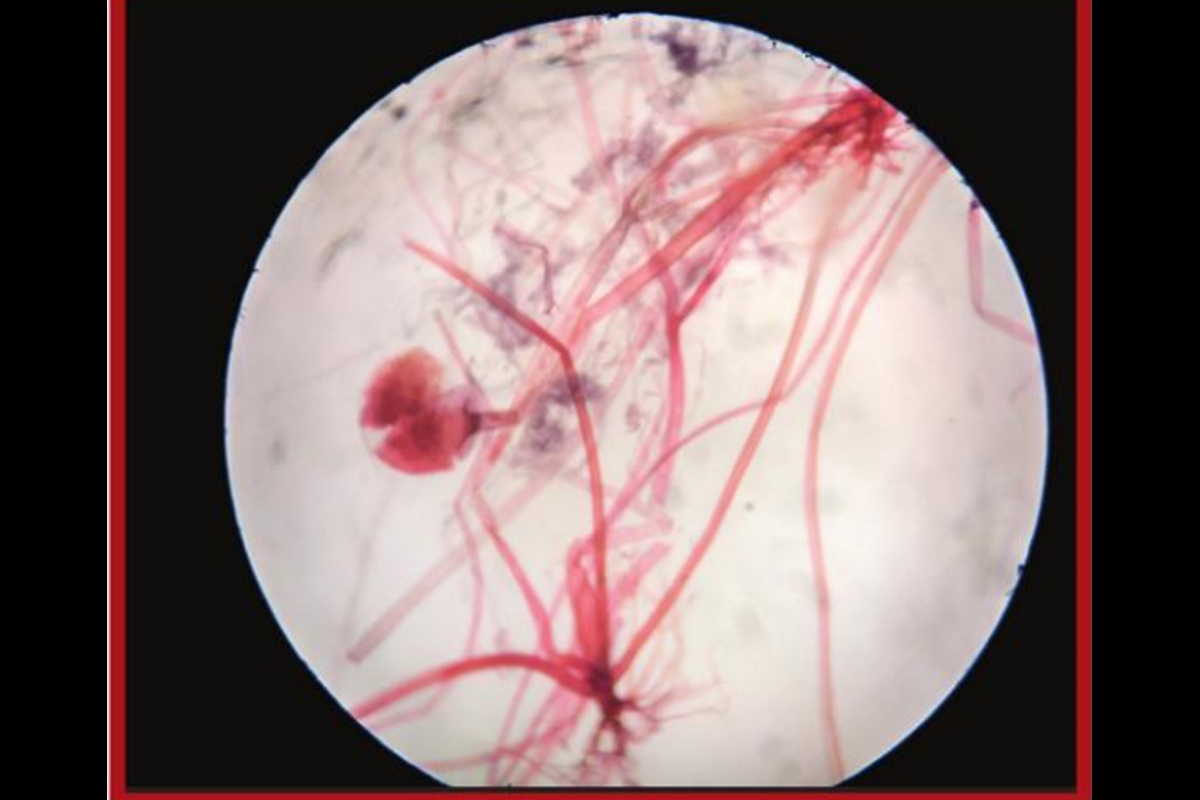Mucor is a very common harmless fungus generally called “bread mould”, while mycosis is a disease occurring due to the growth of a fungus.
Mucor grows on damp and favourable substratum, especially during rainy seasons, as a white cottony mould. As the fungus grows, the aerial hypha develops and its tip swells, looking like a pin.
Advertisement
Then, it is called a “pin mould”. In the early stages of growth, the plant body is white but with the development of sporangia, the colour of the mycelium changes to yellow, then yellowish brown and finally, black. The tips of the aerial hyphae bear the sporangia, which become black when mature and then, the whole mycelium appears so. For that reason, the fungus, mucor, is called “black mould”. It is then that the innocent and harmless mucor infects humans and leads to a fatal situation. The fungus has become known by its new name, black fungus. Therefore, mucor is the black fungus and the fungal disease is called mucormycosis. Many of the human fungal infections are opportunistic or in other words, they occur in conditions with impaired host immune mechanisms. Such conditions include defective neutrophil function, administration of corticosteroids, immune-suppressive therapy, and immune-deficiency states (congenital and acquired). Common fungal infections are mycetoma, candidiasis and very rarely, mucormycosis.
Mucormycosis or black fungus disease
It usually affects people whose immune systems have been compromised. These clinical features are noticed during mucormycosis — nasal blockage, bleeding and discharge from the nose are initial features. On endoscopic visualisation of the nasal cavity, unmistakable black “eschar” (slough or dead tissue)-coated masses will be present, which gives away the diagnosis. As the disease progresses, the palate is destroyed as a large, black necrotic mass may be seen on opening the mouth. When the orbit is involved, there will be proptosis (protrusion of eyeball), loss of movements of the eyeball with consequent double vision. Eye pain and redness with blindness can follow. If the brain is invaded due to blood vessel blockage, there will be strokes, haemorrhages and even death. Patients can also have headache, drowsiness, limb weakness and seizures. If the fungus goes in through a cut or burn, it can cause local infections. But if it goes in through the sinus, it can affect the eyes and eventually the brain, leading to a fatal condition. This disease is not contagious – it doesn’t spread from one person to another.
Prevention and treatment
As black fungus infections are on the rise; the knowledge of prevention and treatment is very important. Wearing masks is compulsory as fungal spores found in air can easily enter the body through the nose. People who work at or visit construction sites should especially pay attention to this. Once a clinical and radiological diagnosis is made, endoscopic evaluation of the nasal cavity can confirm a fungal lesion. Immediate surgical debulking is a must. The entire nasal cavity needs to be scoured and all fungal, necrotic tissue needs to be removed. If the orbit is involved, surgeries as drastic as exenteration of the eye socket contents may be required. If the infection has spread to the brain, surgical intervention should be undertaken a couple of hours after diagnosis. In tandem, medical management with antifungal drugs, namely the injection liposomal amphotericin B, needs to be initiated. Older form amphotericin deoxycholate is significantly nephrotoxic. The liposomal cousin, however, is safe and effective. Posaconazole tablets/suspension and intravenous forms are available and are used in lieu of amphotericin, if the latter is not tolerated by the patient. Following several weeks of intravenous medication, depending on response, the patient is put on oral posaconazole sustained release tablets for several months. Isavuconazole is also an alternative drug that can be used. Drugs are stopped after clinical and radiological clearance of the disease. During treatment, judicious use of steroids (keeping blood sugar levels under control), antibiotics, and other antifungal drugs need to be continued. Broad-spectrum antibiotics not only wipe out the potentially pathogenic bacteria but also the protective symbionts and commensals. Antifungals like voriconazole inhibit Aspergillosis but mucor remains unscathed and thrives due to lack of competition.
Relationship between mucormycosis and Covid-19
Doctors believe mucormycosis, which has an overall mortality rate of 50 per cent, may be being triggered by using steroids, a life-saving treatment for severe and critically ill Covid-19 patients. Steroids reduce inflammation in the lungs during Covid-19 and appear to help stop some of the damage that can happen when the body’s immune system goes into overdrive to fight off the novel coronavirus. But they also reduce immunity and push up blood sugar levels in both diabetic and non-diabetic Covid-19 patients. It is thought that a drop in immunity could be triggering the cases of mucormycosis. Mucormycosis can occur any time after Covid-19 infection, either during hospital stay, or several days to a couple of weeks after discharge. Covid-19 damages the airway mucosa and blood vessels. It also causes an increase in serum iron, which is extremely important for the fungus to grow.
The writer is associate professor and head, department of botany, Ananda Mohan College, Kolkata.











